$150,000 – $200,000 for a simple telemedicine platform or $300,000 – $450,000 for a more robust solution – that’s how much you need to budget for creating a custom telemedicine app.
Does that fully answer your question? I hope not.
Because the answer to “How much does it cost to develop a telemedicine app?” is not always so straightforward. The cost of developing a telemedicine app depends on several factors, such as the complexity of the application, its features, and other technical and not-so-technical requirements.
You may also be wondering:
- Why do companies like TelaDoc spend millions of dollars developing their telemedicine platforms?
- What exactly do I get for the mentioned prices?
- What about adopting an off-the-shelf telehealth app?
In this blog, we will dissect the cost of telehealth app development, providing a comprehensive breakdown that will help elucidate where those dollar figures come from. We’ll dive into the various factors influencing the cost, from features to technology and even maintenance costs.
We’ll also touch on why a white label telehealth solution blows everything else out of the water price-wise when it comes to telemedicine app development. So, let’s dig in!
Top Takeaways:
- Developing a telemedicine app from scratch is indeed a costly venture, especially when considering the time, resources, and specialized knowledge required.
- Utilizing pre-existing components like code snippets for critical features like video conferencing or appointment scheduling can significantly reduce the overall cost. This is because you’re not reinventing the wheel but leveraging technology that’s already been developed and tested.
- Opting for a white label telehealth solution, like our pre-built telehealth components, is not only cost-efficient but is also a savvy strategy for those aiming to deliver high-quality telehealth services quickly or just approaching the digital health paradigm.
Table of Contents:
- Telemedicine App Costs: Here’s Your Quick Breakdown
- The Pre-Development Phase: Setting the Groundwork
- Why Feature-Based Estimates Never Work
- Why Shortcuts Won’t Work in Telemedicine App Development
- Additional Factors Influencing the Cost of Telemedicine App Development
- Detailed Breakdown of Telehealth App Development Costs
- Post-Development Costs: The Journey Beyond Launch
- The Total Cost: What To Expect?
- How Topflight Cuts Telemedicine Development Costs
- Real-world Example: Our Experience in Telemedicine App Development
Telemedicine App Costs: Here’s Your Quick Breakdown
The cost of telemedicine app development varies based on the features you choose, the level of customization, and the compliance requirements like HIPAA. Below is a detailed breakdown of costs for specific features commonly included in telemedicine apps.
| Feature | Estimated Cost ($) | Description |
|---|---|---|
| User Login & Profiles | $10,000 – $20,000 | Basic authentication and user profile management. |
| Video Conferencing | $20,000 – $40,000 | Real-time video consultation capabilities. |
| In-App Messaging | $10,000 – $25,000 | Secure chat between patients and providers. |
| Appointment Scheduling | $12,000 – $25,000 | System for booking and managing appointments. |
| Prescription Management | $15,000 – $25,000 | Handling e-prescriptions within the app. |
| Payment Gateway Integration | $8,000 – $15,000 | Facilitating in-app payments. |
| EHR Integration | $15,000 – $30,000 | Connecting with Electronic Health Records systems. |
| HIPAA Compliance | $20,000 – $50,000 | Ensuring the app meets regulatory standards. |
| Total Estimated Costs | $110,000 – $230,000+ | Varies based on feature complexity and compliance. |
The cost to develop a telemedicine app typically ranges from $110,000 to $230,000+ depending on the features and compliance requirements. Including advanced functionalities like AI diagnostics or EHR integration can significantly increase the budget and timeline.
Quick Telehealth Stats
Let’s save some time by skipping the impressive stats about the global telemedicine market illustrating the growth of telemedicine. If you’re reading this blog, you’re already aware of the future of remote medical care and its importance to you.
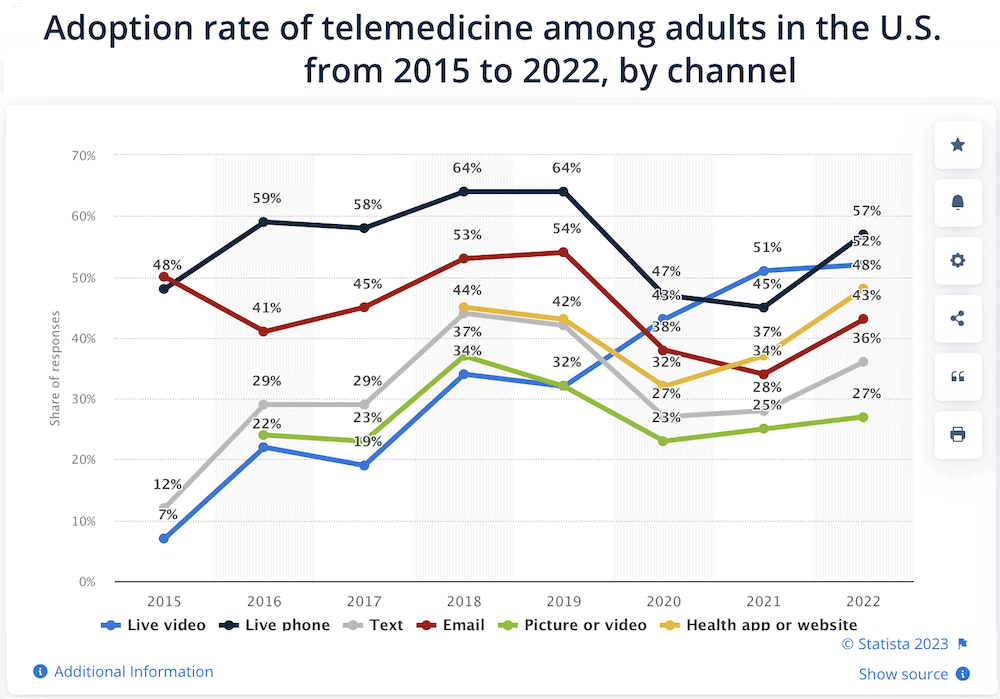 Image credit: Statista
Image credit: Statista
And to make sure we’re on the same page, by telehealth and telemedicine, we both understand primarily HIPAA-compliant video calls between patients and providers. We’re not going to cover similar tools:
- doctor-on-demand apps
- remote patient monitoring solutions
- medical internet-of-things software
So, where do you begin estimating the necessary investment for developing a telehealth solution?
The Pre-Development Phase: Setting the Groundwork
In this pre-development phase, the bulk of the expenses are typically out-of-pocket, as you’ll primarily rely on your internal team for groundwork. The involvement of an external app development company at this stage is often minimal.
Market Research: Analyzing Competitors and Identifying Gaps
Market research is a crucial step in any product development cycle, and telemedicine app development is no exception. After all, you need to stay ahead of the competition to stand out in today’s highly competitive market.
It’s essential to understand what your competitors are offering so you can identify gaps and areas for improvement. As such, the discovery phase should include analyzing competitors’ apps and interviewing healthcare service providers.
This helps you get a feel of what providers and patients really need from a telemedicine app (e.g., which mhealth conditions to treat) so that you can incorporate their needs in the product roadmap. Market research also allows you to estimate how much it’ll cost to create a superior product on the market.
Price impact: $1,800.
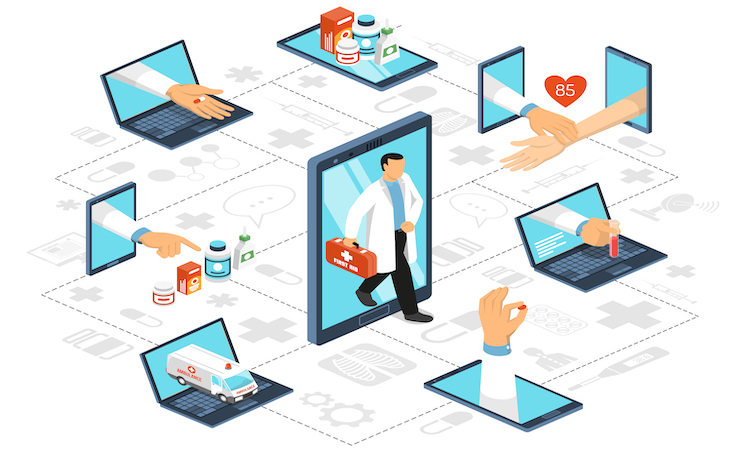
Requirement Gathering: Aligning with Healthcare Standards
The process of gathering requirements is key to align the app’s features with healthcare standards. It involves understanding the nuances of the healthcare industry, including regulations, privacy concerns, and the need for seamless communication between various stakeholders. In this stage, you need to outline the app’s features and workflows and identify the tech stack for your telemedicine app.
You’ll need to consider factors like HIPAA compliance, integration with EHR, and the need for a user-friendly interface that caters to both doctors and patients. It’s also important to consider scalability and future-proofing your app to handle increased user loads in the future. This phase may require the involvement of health IT consultants, adding to your pre-development costs. However, this investment is crucial to mitigate risks and ensure your app’s success in the long run, regardless of the technologies used to build it.
Price impact: around $3,000.
Why Feature-Based Estimates Never Work
Feature-based estimates of telemedicine app development costs are often unreliable. Not only are feature sets prone to change, but the approach fails to account for the importance of developing a robust back-end infrastructure and well-thought-out user experience design.
Ultimately, it’s important to take into consideration the complexity of each feature as well as its potential impact on other features in the system. A feature may look simple on its own (e.g., integration with payment gateways), but it could involve a lot of underlying processes that influence the cost of development.
For example, artificial intelligence, if organically woven into a platform to help clinicians with decision-making, can send its cost of implementation into the stratosphere.
Above all, it is crucial to acknowledge that the time required to develop a particular feature can vary depending on the development team involved.
Therefore, it’s better to estimate your development partner. Every software development company has its own rate. For example, at the time of writing this blog, a simple blended rate of developing an app at Topflight is $125/h. The rate covers a complex team composition:
- UX/UI engineers
- QA (quality assurance) testers
- DevOps specialists
- Full-stack or mobile developers (in case you envision healthcare mobile application development)
- Strategy/technology consultants
- Product and project managers
And sometimes, when you meet the right people, you may get what you want. For example, at Topflight, we’ve accumulated enough experience to package it as telehealth code components that can be used for building telehealth apps.
You can buy bits (and bytes) of ready-made code libraries that help to quickly implement some of the must-have telemedicine app features:
- user authentication
- appointment scheduling
- chatting
- audio/video calls
But even then, this only works for you after you have checked these features and verified that they suit your business model. For example, you might want to check if a solution allows patients to interact with a chatbot to perform basic actions like scheduling an appointment or if it allows doctors to reschedule, etc. Different healthcare organizations have different workflows, e.g., a mental health clinic vs. a cardiology practice.
You’d use these ready-made code snippets to bootstrap the development of a custom application. Feel free to reach out to our experts to learn more if you want to make a telemedicine application using such components.
Get ideas for your telehealth application in our blog about the best telemedicine apps.
Why Shortcuts Won’t Work in Telemedicine App Development
When developing a telemedicine app, it might be tempting to cut corners to reduce initial development costs. However, this approach can backfire, especially in such a highly regulated sector. Here’s why taking shortcuts is not advisable:
Regulatory and Compliance Requirements
In the realm of telemedicine, compliance with regulations such as HIPAA is not optional. From day one, your app must ensure the secure handling of Protected Health Information (PHI). Unlike other types of health apps where you might defer HIPAA compliance to later stages, telemedicine apps must be fully compliant from the start to protect patient data and maintain trust.
Essential Integrations
Telemedicine platforms often require integration with Electronic Health Records (EHRs) to provide comprehensive care. Skipping EHR integration can severely limit the app’s functionality and attractiveness to large healthcare systems that demand this capability. While some health apps can afford to omit EHR integration initially, telemedicine apps typically cannot.
Platform Considerations
Though it might seem cost-effective to start with either a web or mobile platform, telemedicine apps usually need to be accessible on both to meet user expectations and provide seamless care. Ensuring compatibility across multiple platforms from the beginning can prevent costly rework and enhance user satisfaction.
The Role of No-Code/Low-Code Solutions
Leveraging no-code or low-code platforms can speed up development and reduce costs. However, these tools have limitations, especially in customizing advanced features required for telehealth services. While they might offer a quick start, they generally fall short in meeting the complex needs of telemedicine applications.
Investing in higher-end development quotes is often justified for telemedicine apps. The need for robust security measures, comprehensive EHR integration, and multi-platform availability makes premium development a necessity rather than a luxury. Cutting costs in these areas can lead to significant issues down the line, such as non-compliance or inadequate performance, which can stall your app’s success.
In summary, while certain strategies to minimize costs may work for other health apps, telemedicine app development demands a more thorough and compliant approach from the outset. Ensuring full regulatory compliance, essential integrations, and multi-platform availability from day one will position your app for greater success and sustainability.
Additional Factors Influencing the Cost of Telemedicine App Development
Beyond the initial development, there are a multitude of factors that can influence the overall telehealth app development cost.
Choice of App Platform:
The choice between web, iOS, Android, or cross-platform applications can significantly impact the overall cost of your telemedicine app development.
Developing a native app for each single platform (iOS and Android) can be quite expensive to enable virtual doctor visits. An economical and savvy choice is to opt for a responsive web-based application. This way, your store-and-forward telemedicine app is accessible on both desktop and mobile browsers, providing a versatile solution that can adjust and respond to any device’s screen size.
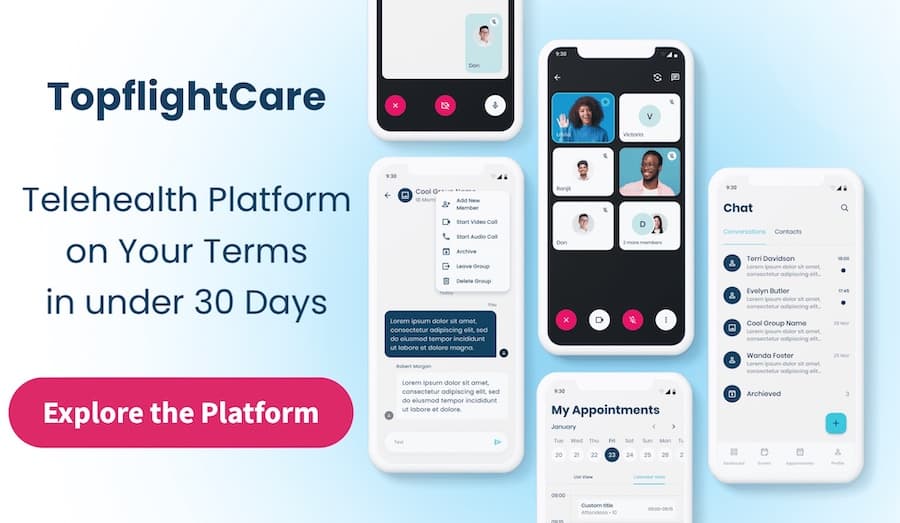 The development of a responsive web application eliminates the need for users to download anything. Instead, the app requires only an internet connection to provide instant access to healthcare from any device. The best part is that a responsive web application ensures a consistent user experience, preserving the look and feel of the app across different devices.
The development of a responsive web application eliminates the need for users to download anything. Instead, the app requires only an internet connection to provide instant access to healthcare from any device. The best part is that a responsive web application ensures a consistent user experience, preserving the look and feel of the app across different devices.
This approach to telemedicine app development not only saves you money but also broadens your reach to a wider user base. From a cost perspective, this option signifies a win-win!
Price impact: significantly less than developing separate native apps. The $150,000-$450,000 fork in the intro assumes the development of a responsive telehealth web application that works cross-platform.
NB: if you plan downloadable mobile apps for iOS and Android, plan to spend another $150,000 or so because mobile app development is a major project on its own.
Regulatory Compliance: HIPAA, GDPR, and More
The need for regulatory compliance is one of the most critical aspects of developing a telemedicine app. It’s important to adhere to all the applicable laws and regulations that govern your industry.
For healthcare providers in the United States, this means adhering to HIPAA (Health Insurance Portability and Accountability Act) standards by protecting patients’ personal data according to strict guidelines. GDPR (General Data Protection Regulation) is also a major factor to consider, as it governs the way in which health information should be collected, stored, and used.
Price impact: hard to pinpoint as it really spreads across the development of security mechanisms for remote monitoring, creating a secure development infrastructure, etc.
Integration with Existing Healthcare Systems
Finally, when developing a telemedicine app, it’s important to consider its potential integration with existing healthcare systems like EHRs (electronic health/medical records), PMS (patient management systems), and other similar healthcare software products used in the healthcare sector.
Integrating your app with existing healthcare systems can be a complex process, but it is essential to ensure seamless communication with other components of the healthcare system.
Price impact: again, hard to pinpoint as it depends on the complexity of the existing IT infrastructure that needs to be integrated. Estimate at least $8,000 – $12,000 for basic integration.
Geographical Location and Hourly Rates of the Development Team
The geographical location of the development team often has an impact on the total price tag. It’s important to investigate the hourly rates and salaries of software developers in your area, as they can range from $30/hr (developers outside the US) to $170/hr for US-based developers.
Additionally, if you are outsourcing telemedicine app development services from a different country, there may be additional costs associated with the project.
Price impact: I’ll be frank, the same telehealth that Topflight can build for you from scratch for, let’s say, $300,000 may cost you $120,000 or so if developed (far away) outside of the US. However, you’re likely to spend the next year after a release fixing bugs and mending nerves and shattered partnerships. Of course, as they say, YMMV – so tread with caution.
Also Read: App Development Costs: The Complete Breakdown
Expertise and Experience of the Development Team
The expertise and experience of the development team are critical factors in determining the cost of a telemedicine app. It’s common knowledge that experts often charge more for their services, but how can you ensure that you are indeed hiring an expert? One of the best ways is to examine their portfolio.
A team’s portfolio can give you insights into the quality of their work, their experience in your industry, and their ability to deliver on complex projects. Pay close attention to the details of their previous projects. Do they have a track record of developing telemedicine apps? Have they worked with healthcare providers similar to you? Are there testimonials from satisfied clients?
You might be tempted to opt for a cheaper, less experienced team to save on costs. However, keep in mind that developing a telemedicine app is a complex process that requires a deep understanding of healthcare regulations, telemedicine software development, and UX design. An inexperienced team may end up costing you more in the long run due to mistakes, delays, and poor-quality work.
Price impact: the cost varies greatly. An expert team may charge a higher hourly rate, but the increased efficiency and quality of work can offset the higher initial cost.
Detailed Breakdown of Telehealth App Development Costs
Let’s dive into the nitty-gritty of the cost of telemedicine app components when looked at through the prism of development stages.
Designing an Intuitive User Interface
The first step in creating an engaging user interface is rapid prototyping. Rapid prototyping is an iterative process where preliminary versions of the user interface are created, tested, and refined based on feedback. This methodology allows adjustments to be made quickly, avoiding costly revisions and reworks later in the development process. It ensures that the end product is not only visually appealing but also highly functional and user-friendly.
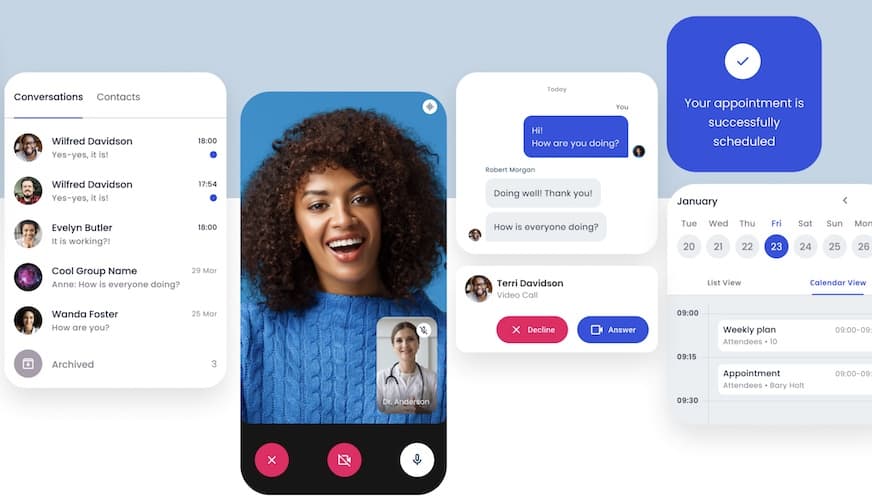 Once the rapid prototyping phase is complete, we move on to the final UI design phase. Here, every element of the user interface, from color schemes and font choices to navigation menus and button placements, is meticulously crafted. Attention to detail is paramount because the UI/UX design not only needs to be aesthetically pleasing but also intuitive and easy to navigate for users.
Once the rapid prototyping phase is complete, we move on to the final UI design phase. Here, every element of the user interface, from color schemes and font choices to navigation menus and button placements, is meticulously crafted. Attention to detail is paramount because the UI/UX design not only needs to be aesthetically pleasing but also intuitive and easy to navigate for users.
When considering the cost impact, both rapid prototyping and the subsequent final design phase account for about 10-15% of the total development cost. It might seem like a significant investment, but remember that a well-designed, user-friendly interface is crucial for the success of any app, especially in the healthcare sector, where users demand ease and efficiency.
Price impact: 10-15% of the total telemedicine app cost. Around $20K for a
Backend Development: Ensuring Smooth Operations
The backbone of a robust telemedicine app lies in its backend development. This involves creating the server side of the app that houses all the complex logic, processes medical data, and ensures smooth data exchange between different parts of the app. Key stages in backend development include setting up servers, databases, third-party and internal APIs (such as video streaming protocols), and implementing robust security measures.
The complexity of backend development is largely determined by the features you choose to incorporate in your app, such as real-time video consultations, secure messaging (including support for text messages), appointment management (including integrations, e.g., with Google Calendar), EHR integration (to review medical history), and more. It’s a substantial part of the project and, while complex, is a necessary investment to ensure the smooth functioning of your telemedicine app.
Price impact: Given its complexity and significant role, backend development accounts for around 40% of the total cost of telemedicine app development. It’s crucial to budget appropriately for this stage, as cutting corners can lead to inefficiencies and potential security risks down the line.
Frontend Development: Crafting a User-Friendly Experience
Frontend development focuses on crafting a user-friendly experience that runs smoothly on various devices and screen sizes. This is the part of the app that users see and interact with. It includes creating interactive elements, optimizing navigation, and ensuring that all features function as intended on all supported platforms.
The main aim of front-end development is to provide a seamless user experience that aligns with the expectations of patients and doctors alike. Cutting corners at this stage can lead to a subpar user experience, which can ultimately impact the success of your app.
Price impact: 30-35% of the total telemedicine app development cost.
The remaining 10% is spent on managerial efforts to organize the talent working on the provider and patient app. Also note that the percentage for all three stages above include all types of work, from communicating to coding and designing, including the QA hours.
Related: How to Build a Virtual Nurse App
Post-Development Costs: The Journey Beyond Launch
Launching your telemedicine app in the market is only half the battle won. The journey beyond the launch – maintenance, updates, customer support, and marketing – plays a critical role in the app’s success and contributes to ongoing costs. Let’s delve into these often overlooked yet significant post-development costs.
Regular Maintenance and Updates: Keeping the App Relevant and Secure
Regular maintenance and updates are essential for the longevity and security of your telemedicine app. Maintenance includes fixing bugs, optimizing performance, and regularly updating the app to comply with the latest healthcare regulations and standards. Plus, the hosting fees for cloud storage. Furthermore, to keep your app relevant and meet user expectations, continuous updates, and feature enhancements must be planned and budgeted.
Price impact: Maintenance and updates can add an additional 15-20% to the initial development cost annually.
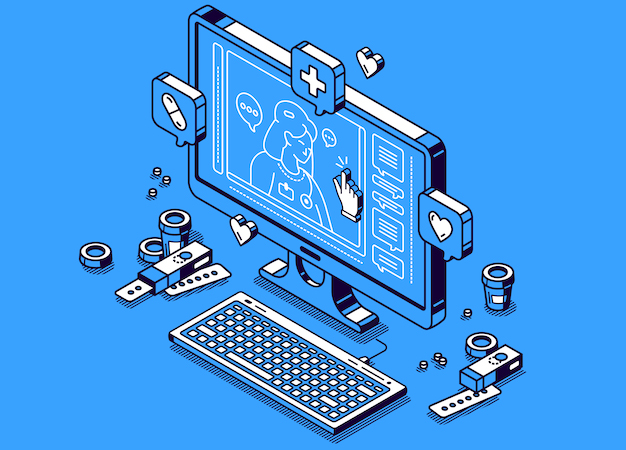
Deployment to App Stores
Once your app is ready, you’ll need to deploy it in the relevant app stores. Apple and Google both charge a one-time fee of $99 for deploying an app in their respective stores. The fee covers all subsequent updates, so once paid, you won’t have to worry about it going forward.
Price impact: tiny.
Customer Support: Keeping Users Engaged
Great user experience doesn’t end at launch. You need to ensure that users remain engaged and have access to quick and excellent support when needed. This includes offering Help Center articles, FAQs, video tutorials, chatbot services, email support, and more. All of these require an additional investment in terms of hiring staff, etc.
Price Impact: Depending on the level of customer support offered, this could add an additional 15% to your total cost annually.
Marketing: Reaching Your Target Audience
Finally, investing in marketing is essential for getting discovered by your target audience. This includes SEO, ASO (App Store Optimization according to search algorithms), PPC campaigns (Pay-Per-Click), and other promotional activities. Depending on the level of marketing needed, you can allocate a budget accordingly.
Price Impact: Variable – depending on what strategy you apply.
The Total Cost: What To Expect?
When it comes to the total cost of developing a telemedicine app, it’s important to remember that quality takes time and money. It’s possible to build an MVP (Minimum Viable Product) with limited functionalities for a much lower cost, but bear in mind that such MVP development will offer basic features only.
If you wish to create a robust, feature-rich app, you should expect the total cost of development to be anywhere between $250K and $400K. This includes everything from strategy, design, engineering, testing, deployment, and maintenance. More info on medical app development cost in our dedicated blog.
How Topflight Cuts Telemedicine Development Costs
Sticker-shock numbers—$300 k+ for an MVP, seven figures for a full release—come from teams reinventing the same HIPAA, video, and EHR wheels. We don’t. RTHM’s Long-COVID platform hit the App Store with patient + provider portals in ~1,400 engineering hours by mixing low-code back-end blocks with targeted custom work. Allheartz’s async rehab app needed just 800 hours for an ML-powered MVP that now halves in-person visits and chops clerical time 80 %—real savings for founders and providers.
Why telehealth teams pick Topflight
Cross-platform efficiency – One React/React Native codebase spans iOS, Android, and web dashboards, shaving whole sprints off the budget.
Ready-made RPM & video modules – Wearable feeds, secure chat, and computer-vision pose tracking drop in instead of being built from scratch.
Compliance baked in – HIPAA, SOC-2, and PHI encryption from day one mean no last-minute “security tax.”
Outcome dashboards investors love – Visit-reduction, revenue-recovery, and engagement metrics instrumented at MVP stage, not tacked on later.
Real-World Example: Our Experience in Telemedicine App Development
The price range detailed at the beginning of this article comes from our direct experience creating a white-label telemedicine app. This platform was developed to accommodate both simple and more comprehensive needs of healthcare providers.
These costs are reflective of the time, resources, and expertise required to design and implement a secure, efficient, and user-friendly telehealth platform. Developing a telemedicine solution from scratch involves copious amounts of planning, designing, coding, testing, and refining.
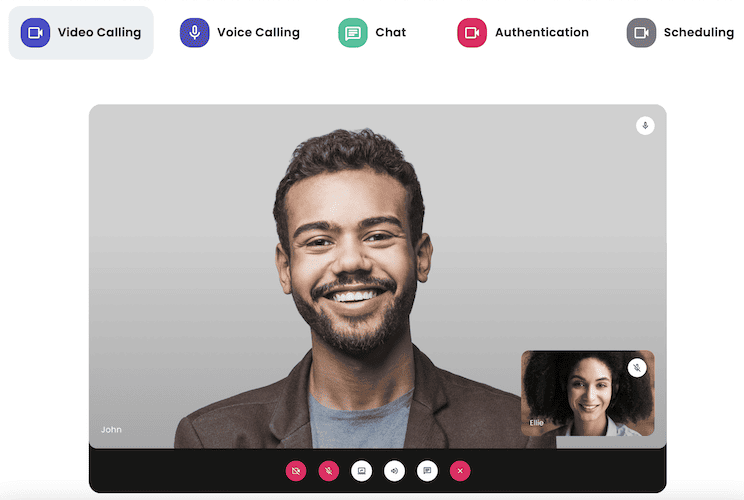
Of course, the white label telehealth approach will only work if the platform fits your use cases, which it quite frankly might:
- HIPAA-compliance
- Robust security measures
- Voice and video calling
- Real-time interactive chat
- Patient/provider authentication
- Appointment scheduling
- Patient-doctor and doctor-doctor comms
- Admin panel (with profile management, etc.)
So, on this bright note, let’s conclude. While developing a custom telemedicine app can be a significant investment, it’s important to remember that the costs reflect the quality, security, and user experience you’re delivering to both healthcare professionals and patients.
At Topflight, we’re committed to making this process as smooth and affordable as possible, enabling you to deliver top-notch healthcare services remotely.
Using our white label components, you can implement a telemedicine application that meets your needs at a fraction of the cost. We invite you to explore how telehealth can revolutionize the way you deliver care, and we’re here to support you in every step of that journey.
Hopefully, after reading this blog, “How much does a telehealth app cost?” is no longer a mystery for you.
Frequently Asked Questions
How much does a basic telemedicine app cost?
While the cost of a telemedicine app can greatly vary based on its features and complexity, a basic app can start anywhere from $250K. However, with our white label solution, you can start as low as $2,200.
Is your white label solution HIPAA-Compliant?
Yes, it’s is fully HIPAA-compliant. We ensure that all patient data is securely stored and transmitted, adhering to all industry standards and regulations.
What is the difference between components and a white label telemedicine app?
Components are individual, reusable elements of software that can be combined in various ways to build a custom application. They provide flexibility to tailor your app to specific needs, but this approach requires additional development time and resources. A white label telemedicine app, on the other hand, is a ready-to-use telehealth platform that covers a wide range of healthcare scenarios. It offers a faster, more cost-effective solution but with less customization than building an app from components.
How does your components manage appointments and keep them organized?
Components have an integrated appointment scheduling feature that allows healthcare providers and patients to manage appointments seamlessly. It is designed to keep track of upcoming appointments, send timely reminders, and reduce no-show rates. This feature aids in maintaining an organized schedule and ensuring the smooth operation of your telehealth services.